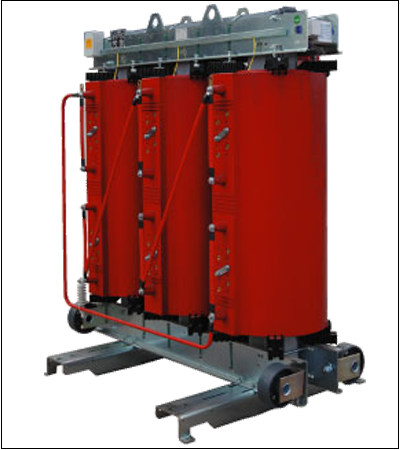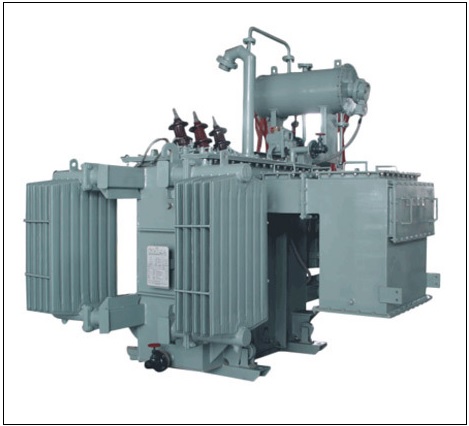Air Cooled & Oil Cooled
1.Air cooling (Dry type transformers)
- Air Natural(AN)
- Air Blast (AB)
 1.Air Cooling (Dry Type Transformers)In this method, the heat generated is conducted across the core and windings and is dissipated from the outer surface of the core and windings to the surrounding air.
1.Air Cooling (Dry Type Transformers)In this method, the heat generated is conducted across the core and windings and is dissipated from the outer surface of the core and windings to the surrounding air.
Air Natural (AN)
This method uses the ambient air as the cooling medium. The natural circulation of the air is used for dissipation of heat generated by natural convection. The core and the windings are protected from mechanical damage by providing a metal enclosure. This method is suitable for transformers of rating up to 1.5MVA. This method is adopted in the places where fire is a great hazard.
Air Blast (AB)
In this method, the transformer is cooled by circulating continuous blast of cool air through the core and the windings. For this external fans are used. The air supply must be filtered to prevent accumulation of dust particles in the ventilating ducts.
2.Oil cooling (Oil immersed transformers)

- Oil Natural Air Natural (ONAN)
- Oil Natural Air Forced (ONAF)
- Oil Forced Air Natural (OFAN)
- Oil Forced Air Forced (OFAF)
2. Oil cooling (Oil immersed transformers)
In this method, heat is transferred to the oil surrounding the core and windings and it is conducted to the walls of the transformer tank. Finally, the heat is transferred to the surrounding air by radiation and convection.
Oil coolant has two distinct advantages over the air coolants.
- It provides better conduction than the air
- High coefficient of conduction which results in the natural circulation of the oil.
Oil Natural Air natural (ONAN)
The transformer is immersed in oil and the heat generated in the cores and the windings is passed on to oil by conduction. Oil in contact with the surface of windings and core gets heated up and moves towards the top and is replaced by the cool oil from the bottom. The heated oil transfers its heat to the transformer tank through convection and which in turn transfers the heat to the surrounding air by convection and radiation.
This method can be used for the transformers having the ratings up to 30MVA. The rate of heat dissipation can be increased by providing fins, tubes and radiator tanks. Here the oil takes the heat from inside the transformer and the surrounding air takes away the heat from the tank. Hence it can also be called as Oil Natural Air natural (ONAN) method.
Oil Natural Air Forced (ONAF)
In this method, the heated oil transfers its heat to the transformer tank. The tank is made hollow, and the air is blown to cool the transformer. This increases the cooling of transformer tank to five to six time its natural means. Normally this method is adopted by externally connecting elliptical tubes or radiator separated from the transformer tank and cooling it by air blast produced by fans. These fans are provided with automatic switching. When the temperature goes beyond the predetermined value, the fans will be automatically switched on.
Oil Forced Air Natural (OFAN)
In this method, copper cooling coils are mounted above the transformer core. The copper coils will be fully immersed in the oil. Along with the oil natural cooling, the heat from the core passes to the copper coils, and the circulating water inside the copper coil takes away the heat. The disadvantage of this method is that since water enters inside the transformer any kind of leakage will contaminate the transformer oil.
Oil Forced Air Forced (OFAF)
In this method, the oil is cooled in the cooling plant using air blast produced by the fans. These fans need not be used all the time. During low loads, fans are turned off. Hence the system will be similar to that of Oil Natural Air natural (ONAN). At higher loads, the pumps and fans are switched on, and the system changes to Oil Forced Air Forced (OFAF). Automated switching methods are used for this conversion such that as soon as the temperature reaches a certain level, the fans are automatically switched on by the sensing elements. This method increases the system efficiency. This is a flexible method of cooling in which up to 50% of rating ONAN can be used, and OFAF can be used for higher loads. This method is used in transformers having ratings above 30MVA.
